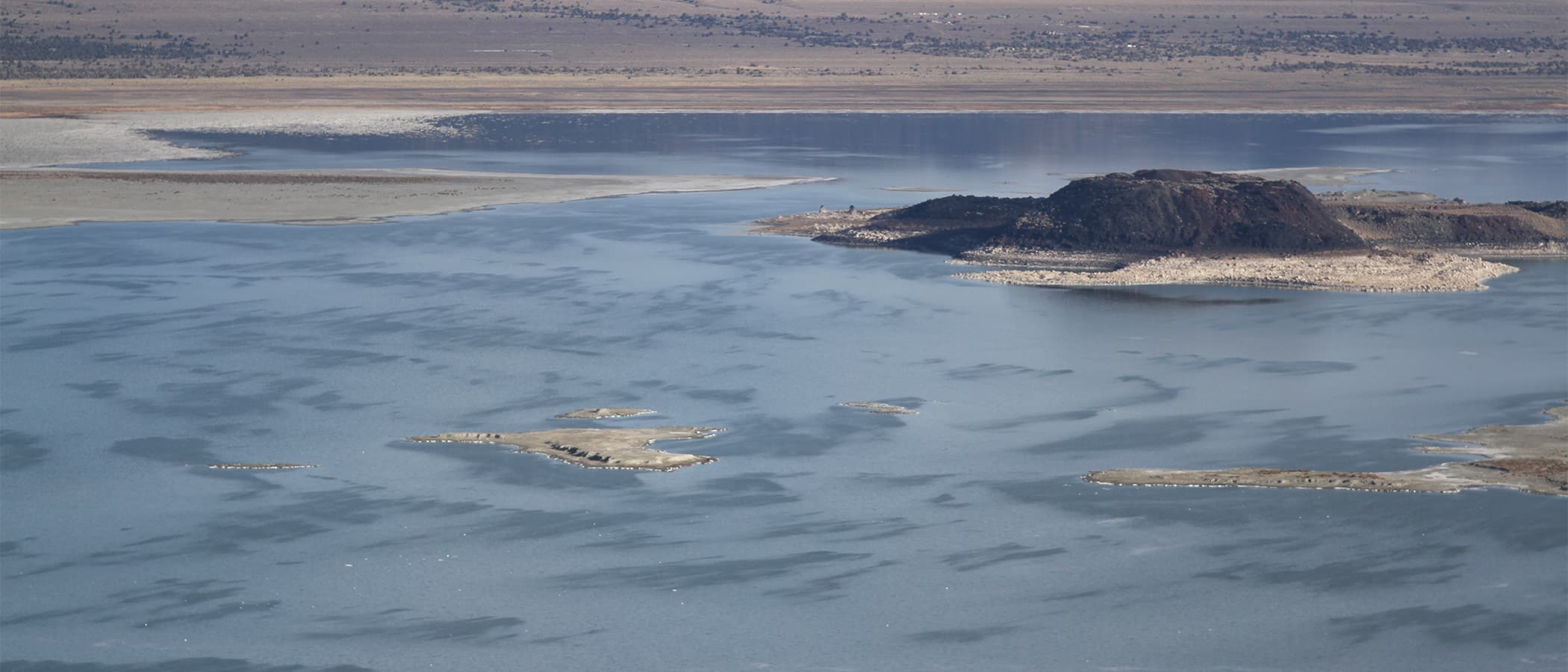
An emergency situation now exists for nesting birds and water quality at Mono Lake. The lake level has fallen a foot and a half since spring and is alarmingly low due to a legacy of Los Angeles Department of Water & Power (DWP) stream diversions, accentuated by recent drought. The Mono Lake Committee is responding with on-the-ground projects, and by asking DWP to contribute something only it can: water.
In a recent letter to DWP, the Committee set forth the reasons action is needed. The lake’s current elevation is 6378.4 feet above sea level, an alarmingly low level that threatens the California Gull colony at Mono Lake. At this elevation, regardless of the outcome of this winter’s precipitation, Mono Lake will not be high enough to protect the gull colony from the threat of coyotes that cross the landbridge and wade or swim between emergent shoals, and across the narrow, shallow channel between the mainland and the nesting islets. The majority of Mono Lake’s nesting gulls are vulnerable if even just one coyote reaches Twain Islet.

Additionally, the salinity of Mono Lake is increasing as the lake level drops. At Mono Lake’s current elevation, the lake’s salinity exceeds the maximum permitted by the federal Clean Water Act antidegradation policy and the lake’s Outstanding National Resource Water designation—a special top tier of protection applied, in California, only to Mono Lake and Lake Tahoe.
Despite these emergency conditions, existing rules allow DWP to divert and export water from the tributary streams in the year ahead, further lowering the lake and worsening the situation. In our letter the Committee requested that DWP solve this problem:
Given these emergency conditions the Mono Lake Committee respectfully requests that the Los Angeles Department of Water & Power help protect nesting birds and lake water quality by voluntarily reducing Mono Basin water exports until the emergency conditions are alleviated, specifically by suspending the export of water diverted from Rush and Lee Vining creeks and delivering that water to Mono Lake instead.
Small amount of water for LA, a big benefit for Mono Lake
If DWP joins the effort, suspending surface water export means leaving 4,500 acre-feet of water in the Mono Basin for Mono Lake, representing less than 1% of Los Angeles’ annual water consumption while making a measurable difference to the security of the nesting colony. In addition, DWP would continue to export approximately 10,000 acre-feet of groundwater captured in the Mono Craters Tunnel in the year ahead.
For a low Mono Lake the change would make a significant difference to the geography of the landbridge, which stretches from Black Point toward Negit Island and adjacent islets. Every inch of elevation in Mono Lake in this area exposes, or covers, many feet of the landbridge—increasing or decreasing the odds of coyotes finding a path to the nesting gulls and their chicks.
Water supply is a shared challenge for Mono Lake and Los Angeles, and the Committee has long supported Los Angeles’ vision for obtaining the city’s water supplies from local sources, an approach that will meet the need of residents in a way that is environmentally responsible at Mono Lake. Just this summer we worked to obtain $60 million in state funding to invest in local water supplies, with a focus on water efficiency projects for the people of Los Angeles. So far DWP has not agreed to join us in this effort, but we are keeping this collaborative proposal on the table.
Our preparations are underway to construct a temporary gull protection fence across the landbridge this winter, in collaboration with management agencies, to safeguard the gulls when they return to nest in the spring. Fencing reduces risk—but it is not foolproof; additionally, it will become ineffective if the landbridge grows substantially due to further lake level decline.
This situation is serious, and it’s the second time the gulls have been threatened in the last five years. In 2017, the Committee constructed a similar temporary electrified fence that was successful in stopping coyotes during the gull breeding season. One year earlier, at the same lake level that exists today, coyotes reached Negit Island and Java Islet, which are stepping stones on the route to Twain Islet and the majority of the gull nests. As a result, the gulls abandoned Java Islet and have not returned since.
The ultimate solution to these two emergency issues, and more, is to raise the level of Mono Lake to 6392 feet—the Public Trust Lake Level established by the State Water Board in 1994. State Water Board Decision 1631 requires that Mono Lake rise 14 feet to protect the lake’s unique and valuable public trust resources for current and future generations, including returning the lake to ecological health, protecting habitat for millions of migratory and nesting birds, submerging dusty exposed lakebed, and restoring tributary streams.
A developing situation
While awaiting a response from DWP, the Committee is working daily on the fence project in collaboration with partners. Stay tuned for developments in this urgent situation here on the blog; you can also sign up for our email and action alert list.
December 14, 2022 update:
Today we received a letter from DWP, responding to our request that it voluntarily deliver more water to Mono Lake. DWP wrote that it does not intend to take any voluntary actions to address the emergency situation by reducing export of water diverted from Mono Lake’s tributary streams.
Top photo by Robbie Di Paolo: A view of the landbridge stretching toward Negit Island (the dark colored cinder cone) from an Eared Grebe survey flight on November 4, 2022.
